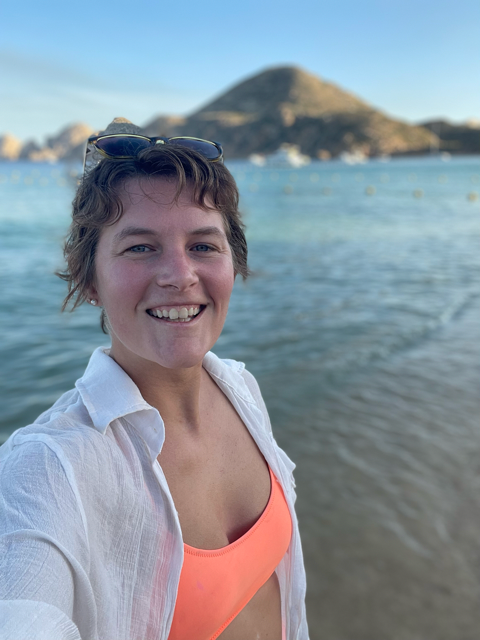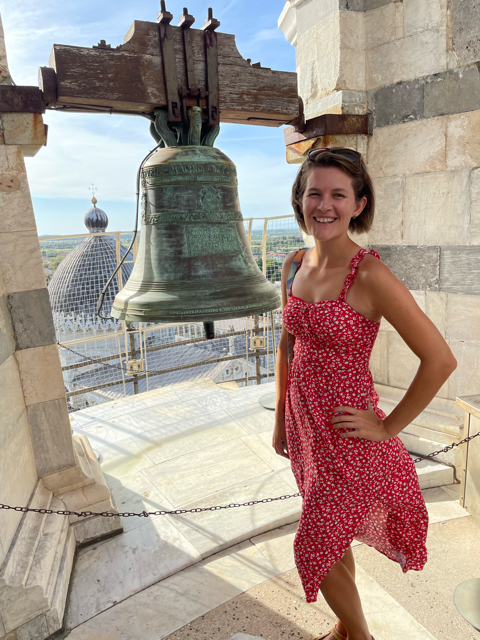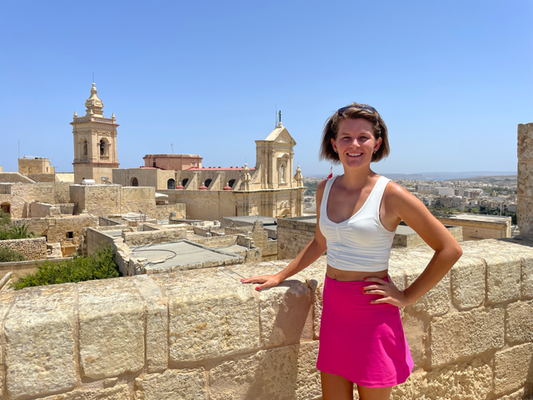
Digital Nomad Guide to Mexico: Best Cities, Safety, and Cost of Living
Share
If you’re dreaming of sunshine, tacos, and a vibrant nomad community, Mexico might just be calling your name. ✨
Since becoming a full-time traveler, Mexico has been one of my favorite countries to spend extended time in. It’s affordable, it’s close to the U.S. and Canada, the food is out of this world, and it’s home to an ever-growing digital nomad scene. Whether you’re craving beach days, colonial charm, or bustling city life, Mexico really has it all.
In this guide, I’ll share the best cities in Mexico for digital nomads (based on both my personal experiences and what other nomads rave about), what you need to know about safety, and a breakdown of the cost of living so you can plan your own adventure with confidence.
Why Mexico is a Digital Nomad Hotspot
Mexico consistently ranks as one of the most popular digital nomad destinations in the world — and for good reason:
- Accessibility: With quick flights from the U.S. and Canada, Mexico is easy to get to. Many major airports offer direct connections to places like Cancún, Mexico City, and Cabo.
- Visa-friendly: Most travelers can get a 180-day tourist visa on arrival, which is one of the most generous in the world. This makes it easy to stay for an extended period without complicated paperwork.
- Infrastructure: While not perfect everywhere, you’ll generally find reliable Wi-Fi, coworking spaces, and plenty of cafes. In larger nomad hubs, it’s easy to plug into a working routine.
- Lifestyle: Mexico is incredibly diverse — one week you could be working from a beach café, the next you’re wandering cobblestone streets filled with history, or hiking in the mountains. And let’s not forget the food: tacos, tamales, mezcal, and fresh seafood galore.
Best Cities in Mexico for Digital Nomads
Mexico is huge, and where you base yourself will completely shape your experience. Here are some of the best places to consider, along with my personal experiences and a few notes on cities I haven’t been to (yet!) but that are worth mentioning.
Playa del Carmen
Playa del Carmen is probably one of the most popular nomad hubs in Mexico — and for good reason.
- Pros: Gorgeous Caribbean beaches, a huge digital nomad and expat community, endless coworking spaces and cafes, and a lively social scene. Playa is also very walkable, especially around the downtown area.
- Cons: Costs have been rising as Playa becomes more popular. It can feel touristy in the central areas, and hurricane season (June–November) can impact travel.

👉 My experience: I spent a month living here, and I loved the balance between beach life and productivity. I met tons of fellow nomads, found some cozy work spots, and still had plenty of time for swimming and tacos.
Oaxaca City
For something completely different, head inland to Oaxaca City. This is a cultural capital with amazing food, colorful streets, and a more relaxed pace.
- Pros: Very affordable, rich in traditions and festivals, a slower lifestyle that’s great for creativity.
- Cons: The digital nomad community is smaller compared to Playa or CDMX, and internet speeds can vary.

👉 My experience: Oaxaca was a refreshing change from the coast. It felt more “authentic Mexico,” and I could see it being the perfect spot if you want a balance between work, learning Spanish, and immersing yourself in local traditions.
Cancún
Cancún is probably the most famous tourist city in Mexico, but as a nomad, it can serve as more than just a vacation spot.
- Pros: Major international airport, easy to reach from the U.S. and Canada, beaches, and tons of accommodation options. It’s also a great base for day trips.
- Cons: Very tourist-oriented, especially in the Hotel Zone, and costs are higher in that area.

👉 My experience: I used Cancún as a base for exploring, including a day trip to Chichén Itzá and Tulum. While I wouldn’t call it the best long-term digital nomad destination, it’s very convenient for arrivals, departures, and short-term stays.
Cabo San Lucas
Located at the tip of Baja California, Cabo has a completely different vibe from the Caribbean coast. Think desert landscapes meeting the ocean.
- Pros: Beautiful beaches, adventure activities, and a fun, resort-town vibe.
- Cons: It’s on the pricier side, and the digital nomad infrastructure isn’t as developed as in Playa or Mexico City.

👉 My experience: Cabo surprised me! While I didn’t find a massive nomad community there, it’s a great spot if you want a mix of work and play, especially if you love outdoor adventures like snorkeling, boating, or hiking.
Cozumel
Just a short ferry ride from Playa del Carmen, Cozumel is a slower-paced island with a reputation for diving and snorkeling.
- Pros: Island life, beautiful reefs, relaxed atmosphere.
- Cons: Limited coworking options, smaller community, and you’ll need to ferry back to Playa for some services.

👉 My experience: I loved the laid-back feel of Cozumel compared to busy Playa. It’s perfect if you want more peace and quiet — just be prepared to plan around the island’s limited digital nomad infrastructure.
Tulum
Tulum is often mentioned in nomad guides, so I’ll include it here with a caveat: I only visited briefly on a day trip to see the archeological site.
- Pros: Trendy, wellness-focused, gorgeous beaches, Mayan ruins.
- Cons: Expensive, Wi-Fi and electricity can be unreliable, and it’s become very tourist-heavy.
👉 My note: While I didn’t stay here long-term, Tulum is often described as a love-it-or-hate-it kind of place. If you’re curious, it could be worth testing out for a week or two.
Mexico City (CDMX)
Even though I haven’t personally lived in Mexico City yet, it’s one of the most talked-about digital nomad hubs in the country.
- Pros: Endless cafes and coworking spaces, incredible food, museums, nightlife, and culture.
- Cons: It’s a massive, busy city, and safety can vary by neighborhood.
👉 Disclaimer: I haven’t been yet, but I’ve heard from countless nomads that CDMX is a must for those who love city energy.
Puerto Vallarta
Puerto Vallarta is another popular coastal city for nomads.
- Pros: Known for being LGBTQ+ friendly, has a strong expat community, and offers beach life with urban amenities.
- Cons: Smaller digital nomad scene compared to Playa or Mexico City.
👉 Disclaimer: I haven’t personally been to Puerto Vallarta yet, but it’s frequently recommended in nomad groups and worth considering. I hope to go there soon!
Safety in Mexico for Digital Nomads
Safety in Mexico is a common concern, and the truth is: it depends where you go. Some areas are best avoided, but in popular nomad hubs, day-to-day safety is manageable with some precautions.
Tips I recommend (and personally follow):
- Stick to safe, central neighborhoods.
- Use Uber instead of hailing taxis on the street.
- Avoid walking alone late at night in unfamiliar areas.
- Keep valuables out of sight.
- Join local Facebook groups to stay updated on real-time safety advice.
👉 As a solo female traveler, I felt safe in places like Playa del Carmen, Cancún, Cabo, and Oaxaca by staying alert and following common-sense precautions.
Cost of Living in Mexico
One of the biggest draws of Mexico is affordability. Here’s a general idea of what you can expect:
- Accommodation: $400–$900/month for a hostel, $900-$1600 for a one-bedroom Airbnb or apartment in most cities.
- Food: $2–$5 for local meals, $10–$20+ for nicer restaurants. Grocery costs are very reasonable.
- Coworking: $100–$200/month, depending on the city.
- Transportation: Uber rides around town usually $2–$5. Buses and colectivos are very affordable, often as low as two pesos per ride for buses.
- Entertainment: Gym memberships $30–$60/month, tours and excursions vary widely but are typically up to $100.
👉 Monthly budget ranges:
- Budget nomad: $800–$1,200
- Mid-range (most nomads): $1,500–$2,200
- Comfortable: $2,500+
Tips for Thriving as a Digital Nomad in Mexico
- Best seasons: High season is December–April (great weather, but more expensive). Hurricane season is June–November.
- Internet: Check Airbnb reviews for Wi-Fi speed; coworking spaces are reliable in Playa, Oaxaca, CDMX.
- Communities: Facebook groups like “Digital Nomads Playa del Carmen” or “Expats in Mexico City” are great for meeting people.
- Apps I used regularly: Uber (transport), Rappi (food delivery), SpanishDict (translation), Airalo (eSIM).
Mexico is one of the easiest and most rewarding countries to start your digital nomad journey. It’s welcoming, diverse, and offers something for every lifestyle — whether you’re looking for busy city energy, quiet cultural immersion, or laid-back island life.
For me, Mexico was the perfect balance of productivity and adventure. It gave me the chance to meet other travelers, dive deep into the culture, and learn how to navigate life as a digital nomad in a place that feels both exciting and accessible.
If you’re considering Mexico as your next base, I can’t recommend it enough. And if you want to dive deeper, I’ll be sharing more detailed guides soon — like a cost breakdown of my month in Playa del Carmen, what to expect in Oaxaca, and tips for exploring Cozumel.
✨ Want insider updates and new travel guides straight to your inbox? Join my email list and I’ll send you my best nomad tips, destination guides, and stories from the road.
FAQs About Being a Digital Nomad in Mexico
Is Mexico safe for digital nomads?
Yes, Mexico can be safe for digital nomads, especially in popular hubs like Playa del Carmen, Oaxaca, and Mexico City. Like any country, safety depends on the area—stick to well-traveled neighborhoods, use rideshare apps like Uber, and practice common sense (don’t flash valuables, avoid walking alone late at night). Many solo female travelers, myself included, feel comfortable here with the right precautions.
How much does it cost to live in Mexico as a digital nomad?
Mexico offers a wide range of budgets depending on the city. On average, digital nomads can live comfortably on $1,200–$2,500 USD per month, including accommodation, food, and coworking. Beach destinations like Playa del Carmen and Cabo tend to be pricier, while Oaxaca and Mexico City are more affordable.
Do I need a visa to work remotely in Mexico?
Most travelers can enter Mexico on a tourist visa that allows up to 180 days of stay. While it’s not technically a “digital nomad visa,” many remote workers use this option. For longer stays, you can look into the Temporary Resident Visa, which allows 1–4 years in Mexico if you meet income requirements. Always make sure you know the requirements of the country you are a citizen of, because entry requirements vary. If you're from the US, check out the State Department website for the latest updates.
What is the internet speed like in Mexico?
Internet speeds vary by city. In popular nomad hubs like Playa del Carmen, Oaxaca, and Mexico City, you’ll find 20–100 Mbps Wi-Fi in coworking spaces and many Airbnbs. Some beach towns or smaller areas may be slower, so always confirm Wi-Fi speeds with your accommodation before booking.
What’s the best city in Mexico for digital nomads?
It depends on your lifestyle. Playa del Carmen is popular for beach lovers, Oaxaca City for culture and affordability, and Mexico City for a cosmopolitan vibe. Puerto Vallarta and Cabo San Lucas are also great if you want coastal living with strong expat communities.
Can solo female travelers work remotely in Mexico safely?
Yes, many solo female digital nomads thrive in Mexico. Stick to safe neighborhoods, use Uber or reputable taxis, and join digital nomad or expat groups for community. Mexico’s welcoming culture makes it a great destination if you take standard travel precautions.


